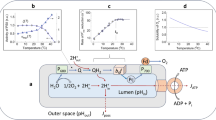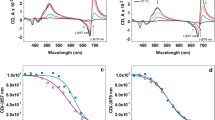Abstract
In-vitro thylakoid protein phosphorylation has been studied in synchronized cells of Scenedesmus obliquus at the 8- and 16-h of the life cycle, stages which are characterized by the maximum and minimum photosynthetic activities, respectively. The stage of maximum photosynthetic activity (8-h) is characterized by the highest protein phosphorylation in vitro and in vivo, by the largest proportion of the heavy subfraction of thylakoids, and by maximum oligomerization of the light-harvesting chlorophyll a/b-protein complex, altogether creating the highest energy charge of the thylakoid membranes. Protein phosphorylation in vitro decreases the amount of the heavy subfraction and increases the amount of oligomerization of the antenna of photosystem I (PSI) (increase of chlorophyll b in the light fraction). Concomittantly, PSII units become smaller (longer time for the rise in fluorescence induction) and photosynthetic efficiency increases (decrease of fluorescence yield). In-vivo protein phosphorylation is controlled mainly endogenously during the 8-h of the life cycle but is exogenously modulated by light to optimize the photosynthetic activity by redistribution of pigment-protein complexes. In-vitro protein phosphorylation seems to restore partially the conditions prevalent in vivo and lost during the preparation of membranes. The effect is greater in 16-h cells which have less-stable membranes. The regulatory mechanism between membrane stabilization and oligomerization on the one hand and redistribution of the light-harvesting chlorophyll a/b-protein complex from PSII to PSI on the other hand remains unexplained. We have confirmed that the mechanism of protein phosphorylation is regulated via plastohydroquinone, but experiments with the plastohydroquinone analogue 2,3,5,6-tetramethyl-p-benzoquinone demonstrated that plastohydroquinone is not solely responsible for the differences in protein phosphorylation of 8- and 16-h thylakoids. The inhibitory effect of ADP and the distinct rates of kinase reaction indicate that the adenylate energy charge and changes in the organization of the photosynthetic apparatus also contribute to the observed differences in protein phosphorylation. Phosphorylation in the presence of 3-(3′,4′-dichlorophenyl)-1,1-dimethylurea indicated that the 32-kDa phosphoprotein and the herbicide-binding QB protein may be the same. These experiments also indicated that 3-(3′,4′-dichlorophenyl)-1,1-dimethylurea-binding reduces kinase activity directly and not only by inhibiting electron transport.
Similar content being viewed by others
Abbreviations
- DCMU:
-
3-(3′,4′-dichlorophenyl)-1,1-dimethylurea
- LHCP:
-
light-harvesting chlorophyll a/b-protein complex
- PSI, II:
-
photosystem I, II
- TMQ:
-
2,3,5,6-tetramethyl-p-benzoquinone
References
Allen, J.F., Bennett, J., Steinback, K.E., Arntzen, C.J. (1981) Chloroplast protein phosphorylation couples plastoquinone redox state to distribution of excitation between the photosystems. Nature 291, 25–29
Allen, J.F., Horton, P. (1981) Chloroplast protein phosphorylation and chlorophyll fluorescence quenching. Activation by tetramethyl-p-hydroquinone, an electron donor to plastoquinone. Biochim. Biophys. Acta 638, 290–295
Anderson, J.M., Waldron, J.C., Thorne, S.W. (1978) Chlorophyll-protein complexes of spinach and barley thylakoids. FEBS Lett. 138, 62–66
Argyroudi-Akoyunoglou, J.H. (1982) Polypeptide composition of the pigment-protein complexes of Phaseolus vulgaris thylakoids. Cation induced disaggregation of oligomeric to monomeric forms correlates with the increase in the ratio F685/F730 in their fluorescence spectra at 77K. In: Cell function of differentiation, FEBS vol. 65, part B, pp. 277–290, Akoyunoglou, G., Evangelopoulos, A.E., Goergatsos, J., Palaiologos, G., Trakatellis, A., Tsiganos, C.P., eds. Alan R. Liss Inc., New York
Argyroudi-Akoyunoglou, J.H., Akoyunoglou, G. (1979) The clorophyll-protein complexes of the thylakoid in greening plastids of Phaseolus vulgaris. FEBS Lett. 104, 78–84
Baker, N.R., Markwell, J.P., Thornber, J.P. (1982) Adenine nucleotide inhibition of phosphorylation of the light-harvesting chlorophyll protein complex. Photobiochem. Photobiophys. 4, 211–217
Barber, J. (1982) Influence of surface charges on thylakoid structure and function. Ann Rev. Plant Physiol. 33, 261–295
Barber, J. (1983) Membrane conformational changes due to phosphorylation and the control of energy transfer in photosynthesis. Photobiochem. Photobiophys. 5, 181–190
Barr, R., Crane, F.L. (1971) Quinones in algae and higher plants. Methods Enzymol. 23, 372–408
Bennett, J. (1977) Phosphorylation of chloroplast membrane polypeptides. Nature 269, 344–346
Bennett, J., Steinback, K.E., Arntzen, C.J. (1980) Regulation of excitation energy transfer by phosphorylation of chloroplast thylakoid membrane polypeptides. Proc. Natl. Acad. Sci. USA 77, 5253–5257
Bishop, N.I., Senger, H. (1971) Preparation and photosynthetic properties of synchronous cultures of Scenedesmus. Methods Enzymol. 23, 53–66
Carter, D.P., Staehelin, L.A. (1980) Proteolysis of chloroplast thylakoid membranes. Evidence for the involvement of the light-harvesting chlorophyll-protein complex in thylakoid stacking and for effects of magnesium ions on photosystem II — light-harvesting complex aggregates in the absence of membrane stacking. Arch. Biochem. Biophys. 200, 374–386
Chua, N.-H., Bennoun, P. (1975) Phylakoid membrane polypeptides of Chlamydomonas reinhardii: wild-type and mutant strains deficient in photosystem II reaction centers. Proc. Natl. Acad. Sci. USA 72, 2175–2179
Gaffron, H. (1939) Über auffallende Unterschiede in der Physiologie nahe verwandter Algenstämme, nebst Bemerkungen über “Lichtatmung”. Biol. Zentralbl. 59, 302–313
Haworth, P., Kyle, D.J., Horton, P., Arntzen, C.J. (1982a) Chloroplast membrane protein phosphorylation. Yearly Review, Photochem. Photobiol. 36, 743–748
Haworth, P., Kyle, D.J., Arntzen, C.J. (1982b) A demonstration of the physiological role of membrane phosphorylation in chloroplasts, using the bipartite and tripartite models of photosynthesis. Biochim. Biophys. Acta 680, 343–351
Heil, W.G., Senger, H. (1986) Thylakoid protein phosphorylation during the life cycle of Scenedesmus obliquus in synchronous culture. Planta 167, 233–239
Horton, P., Black, M.T. (1981) Light-dependent quenching of chlorophyll fluorescence in pea chloroplasts induced by adenosine-5′-triphosphate. Biochim. Biophys. Acta. 635, 53–62
Krupinska, K., Akoyunoglou, G., Senger, H. (1985) Relationship between light-induced state I/II-transitions and Mg2+-effect on fluorescence, tested in synchronous cultures of Scenedesmus. Photochem. Photobiol. 41, 159–161
Kyle, D.J. (1985) The 32,000 dalton QB protein of photosystem II. Photochem. Photobiol. 41, 159–164
Kyle, D.J., Arntzen, C.J. (1983) Thylakoid membrane protein phosphorylation selectively alters the local membrane surface charge near the primary acceptor of photosystem II. Photobiochem. Photobiophys. 5, 11–25
Kyle, D.J., Staehelin, L.A., Arntzen, C.J. (1983) Lateral mobility of the light-harvesting complex in chloroplast membrane controls excitation energy distribution in higher plants. Arch. Biochem. Biophys. 222, 527–541
Malkin, S., Armond, P.A., Mooney, H.A., Fork, D.C. (1981) Photosystem II photosynthetic unit sizes from fluorescence induction in leaves. Plant Physiol. 67, 570–579
Markwell, J.P., Baker, N.R., Thornber, J.P. (1982) Metabolic regulation of the thylakoid protein kinase. FEBS Lett. 142, 171–174
Melis, A., Homann, P.H. (1976) Heterogeneity of the photochemical centers in system II of chloroplasts. Photochem. Photobiol. 23, 343–350
Melis, A., Schreiber, U. (1979) The kinetic relationship between the C-550 absorbance change, the reduction of Q and the variable fluorescence yield change in chloroplasts at room temperature. Biochim. Biophys. Acta 547, 47–57
Mell, V., Senger, H. (1978) Photochemical activities, pigment distribution and photosynthetic unit size of subchloroplast particles isolated from synchronized cells of Scenedesmus obliquus. Planta 143, 315–322
Senger, H. (1970) Quantenausbeute und unterschiedliche Verhalten der beiden Photosysteme des Photosyntheseapparates während des Entwicklungsablaufes von Scenedesmus obliquus in Synchronkulturen. Planta 92, 327–346
Senger, H. (1981) Development of the photosynthetic apparatus in eukaryotic algae. In: Photosynthesis, vol. V, pp. 433–445, Akoyunoglou, G., ed. Balaban Int. Science Services, Philadelphia
Senger, H., Bishop, N.I. (1972) Changes in fluorescence and absorbance during synchronous growth of Scenedesmus. In: Proc. 2nd Int. Congr. on Photosynthesis Res., vol. 1, pp. 678–687, Forti, G., Avron, M., Melandri, A., eds. Dr. W. Junk Publ., Dordrecht Boston Lancaster
Senger, H., Krupinska, K. (1986) Changes in molecular organization of thylakoid membranes during the cell cycle of Scenedesmus obliquus. Plant Cell Physiol., 27, 1127–1139
Senger, H., Pfau, J., Werthmüller, K. (1972) Continous automatic cultivation of homocontinuous and synchronized microalgae. In: Methods in cell physiology, vol. V, pp. 301–323, Prescott, D.M., ed. Academic Press, New York
Shochat, S., Owens, G.C., Hubert, P., Ohad, I. (1982) The DCMU-binding site in thylakoids of Chlamydomonas reinhardii. Role of photosystem II reaction center and phosphorylation of the 32–35 kD polypeptide in the formation of the high affinity binding site. Biochim. Biophys. Acta 681, 21–31
Staehelin, L.A., Arntzen, C.J. (1983) Regulation of chloroplast membrane function: protein phosphorylation changes the spatial organization of membrane components. J. Cell Biol. 97, 1327–1337
Vermaas, W.F.S., Steinback, K.E., Arntzen, C.J. (1984) Characterization of chloroplast polypeptides in the 32 kDa region. Polypeptide extraction and protein phosphorylation affect binding of photosystem II directed herbicides. Arch. Biochem. Biophys. 231, 226–232
Author information
Authors and Affiliations
Additional information
Dedicated to Professor Dr. W. Nultsch on the occasion of his 60th brithday
Rights and permissions
About this article
Cite this article
Heil, W.G., Senger, H. Correlation between thylakoid protein phosphorylation and molecular organization of the photosynthetic apparatus in a dynamic system. Planta 170, 362–369 (1987). https://doi.org/10.1007/BF00395028
Received:
Accepted:
Issue Date:
DOI: https://doi.org/10.1007/BF00395028




